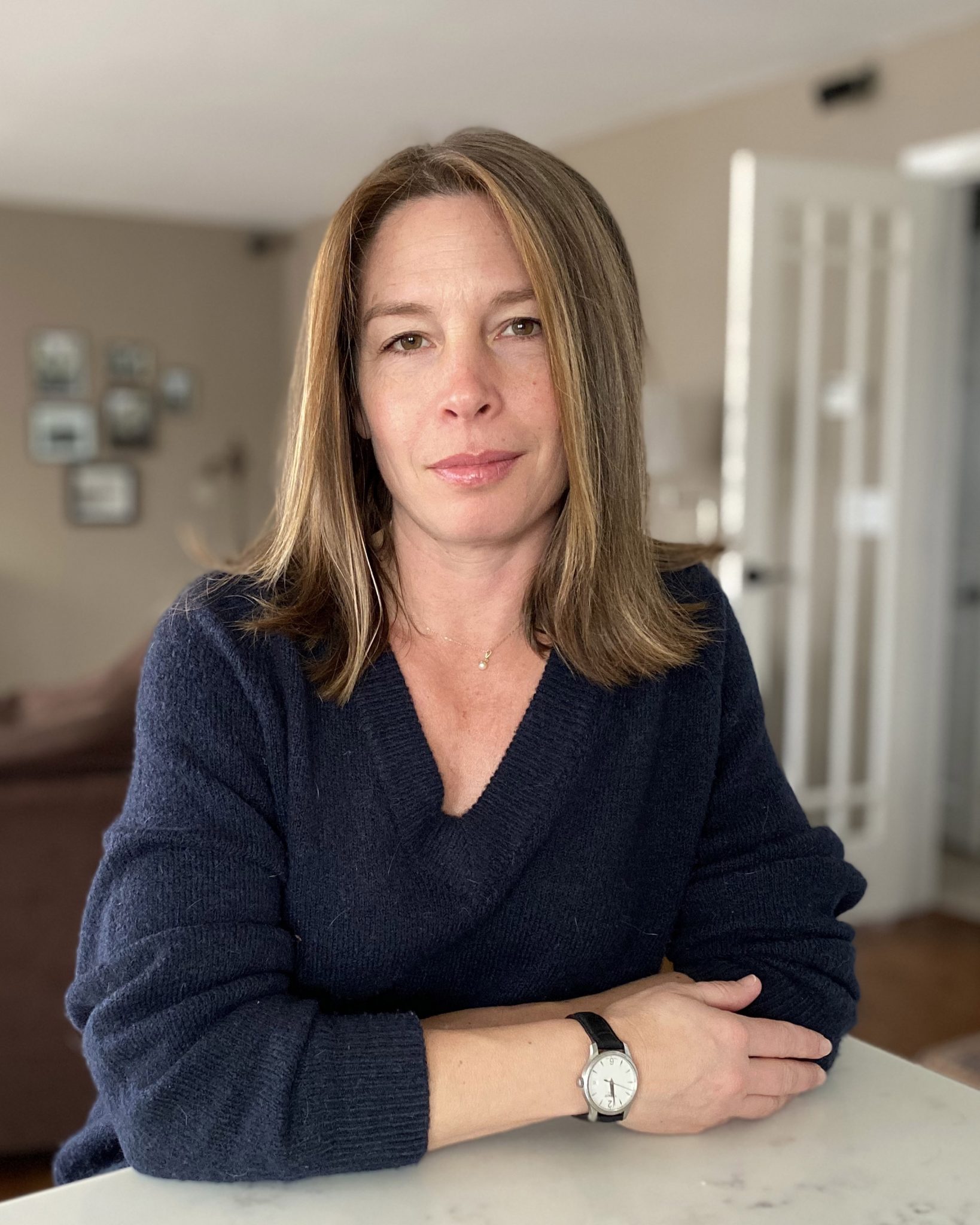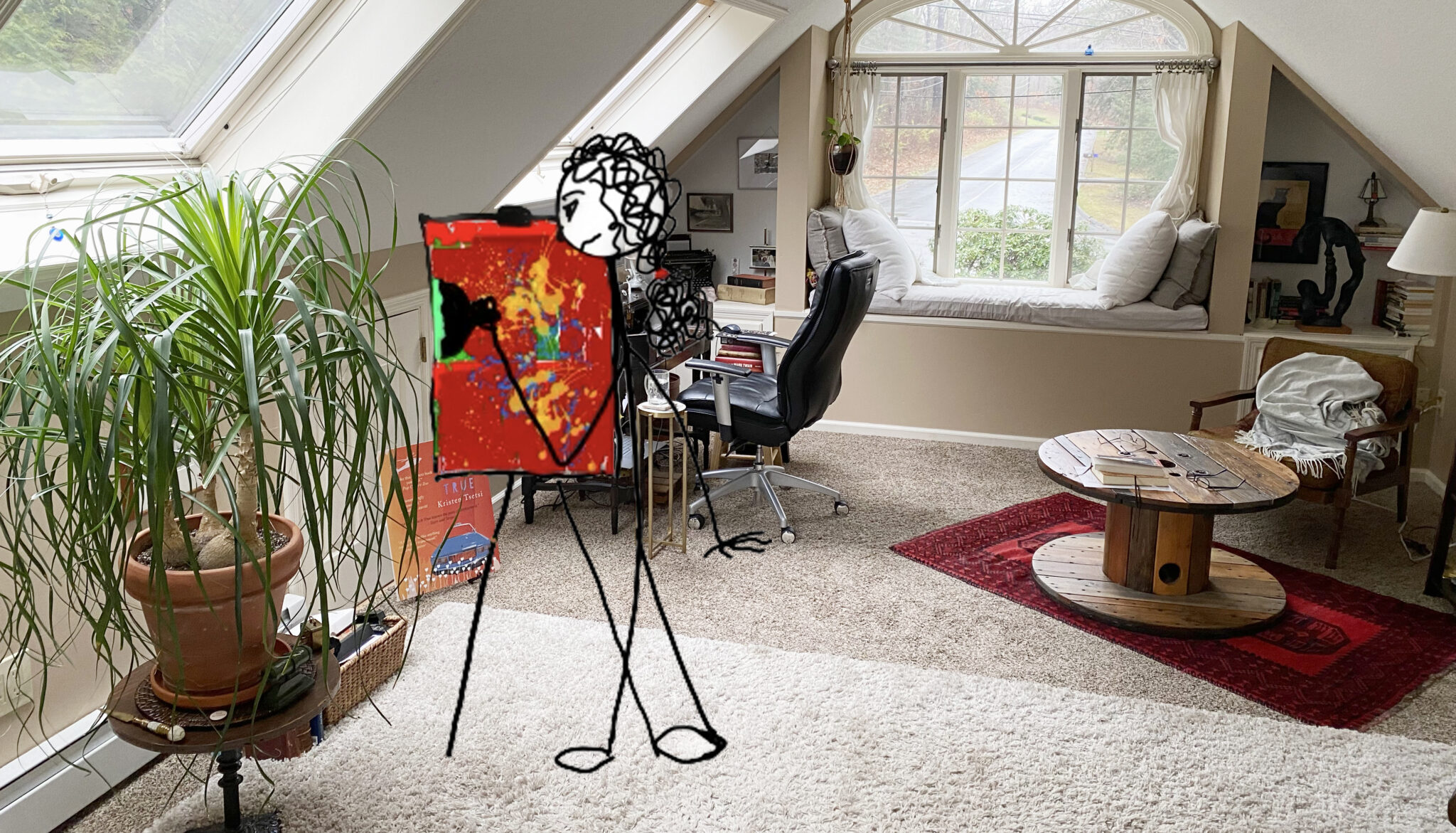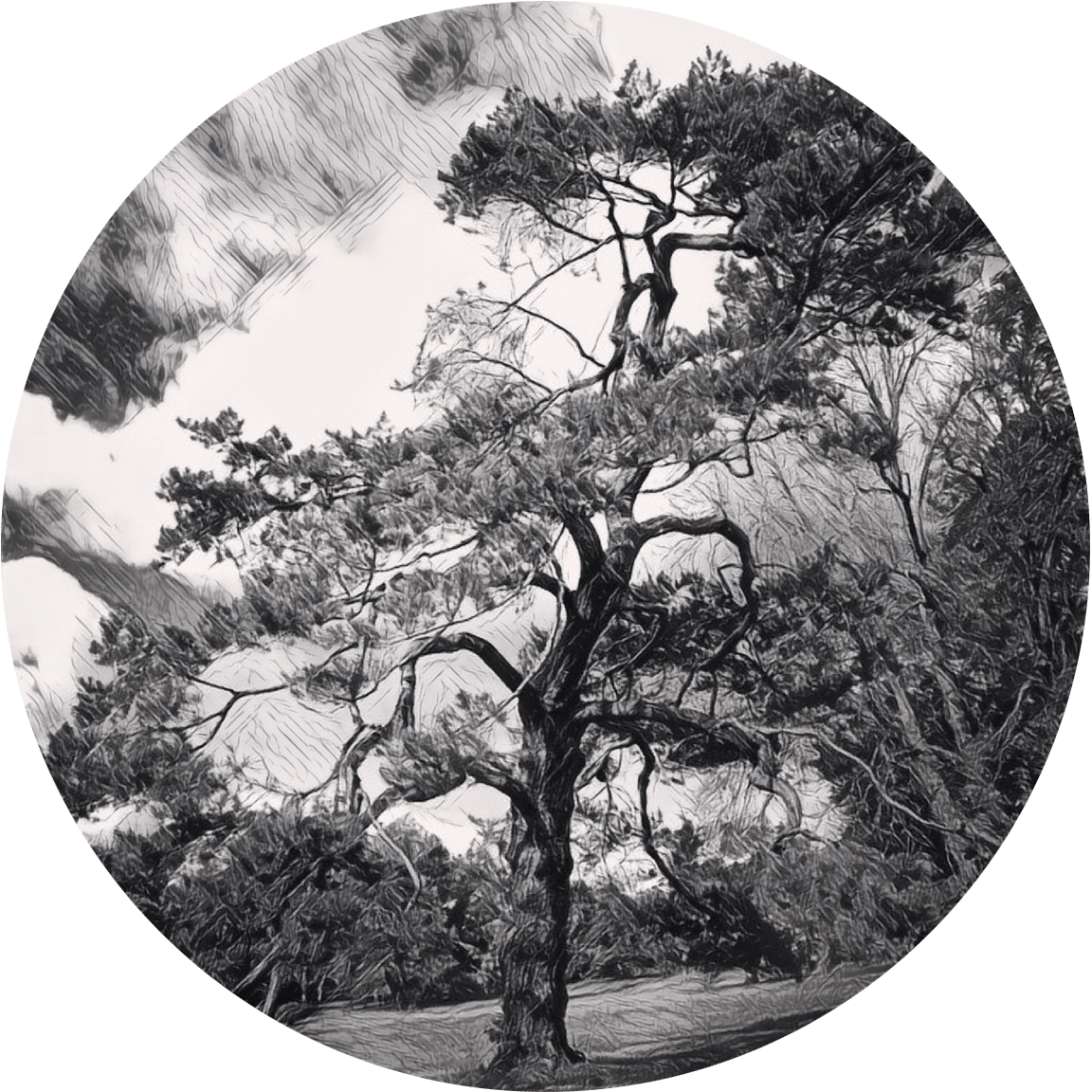Especially if you’re a writer
Imagine a painter.
She stands at her easel under a skylight, a cup of brushes on a nearby table. The drop cloth under her feet is dotted and smeared with color. An abstract arrangement of shapes covers the canvas in front of her. She dips her brush in a blob of black on her palette and extends her arm to paint a section th —
“Are you sure you want to do that?”
She looks over her shoulder, brush held mid-air.
“Red would be better.”
She assesses the painting. “Black.”
“For this kind of painting, with those particular shapes and colors, you want red.”
She takes and holds a breath. She rinses the brush, blots it dry, applies a smudge of red, and stands back for a look before going back to it with the red-tipped bristles to add, in the top right corner, a —
“Oh, no.”
She drops her arm to her side. “What.”
“Well, what are you going to put there?”
“A star.”
“Hm.” There’s a thoughtful silence. “I see what you’re going for, but what if — just what if — you do one of those squiggle lines somewhere across the middle? That’s what people are doing these days, isn’t it? What people are buying? Those scribbles somewhere in the middle. Any way you want, of course. You know. Go wild!” A pause. “But probably not red. No, do blue. Navy.”
This obviously doesn’t reflect the life of a painter. We reserve that kind of micromanage-y backseat driving for writers.

It seems painters are trusted to create after being encouraged (as new artists) to study past masters, learn the fundamentals of technique, pay attention to the evolving art world around them, etcetera.
But they’re not only seemingly trusted to create; they’re also encouraged to be original. Painter Doug Swinton, who in his website bio rejoices in the freedom of flitting from subject to subject and who says trying to describe his art is “like trying to hit a moving target,” writes in “10 Painting Rules and When to Break Them” that following the rule of thirds (a standard guideline for creating a compelling balance of objects within the confines of a canvas/frame) “is good to follow if you’re struggling with composition. However, if you rely on it too often, your work may become formulaic and predictable.”
“Formulaic and predictable” isn’t a quality artists — those who paint, anyway — are expected or asked to strive for. “Discover your personal style and distinguish yourself,” Contemporary Art Issue advises painters who want to succeed. And, “Novelty,” declares the art website FeltMagnet, and “personal and emotional involvement” are two of the three critical elements of a great painting, following technique and technical aspects.
An artist’s blank canvas presents them with an opportunity to make absolutely anything they want, in any style they want, using any colors, tools, techniques, or objects at their disposal. They can make something powerful, something outlandish, something fun, something thought-provoking.
Something new.
The possibilities for artist painters are endless, exciting, and daunting in ways they likely aren’t for those whose painting is more of a craft or a trade, as much painting was pre-Renaissance when work was commissioned and closely monitored and painters were at the mercy of the person paying for it: This style, please. These colors. Not that type of background, but this one.
We all have a decent understanding of the difference between painting as a trade and painting as an art. A similar understanding — or appreciation — of the difference between writing as a trade and writing as an art isn’t as apparent.
In the novel-writing world, you have, on one hand, ambitious, creative trades- / craftspeople. They want to write novels, and they want to make money doing it. It’s creative, but it’s business. They typically choose their favorite genre and study the formulas, become intimately familiar with the work of other writers in the genre, analyze what sells and what doesn’t and why, evaluate their specific market, and write to their audience. They give their readers something engrossing and entertaining, if formulaic and predictable — because formulaic and predictable is a safe sell and is even encouraged. (Search “mystery genre rules,” and results will show, respectively, The “Rules” of Detective Fiction, 6 Rules for Writing Great Mystery Novels, 17 Rules of Mystery Writing, S.S. Van Dine’s 20 Rules for Writing Detective Stories, and Writing a Mystery Novel: 7 Items Your Story Needs.)
On the other hand are the writers who are artists, who look at a blank page the same way an artist painter looks at a blank canvas: it could become anything. The blank page is exciting and daunting. So many methods, so many techniques to use to create something provocative, something mind-opening, something fun, frightening, gripping, or exciting.
Something new.
They write with the story, message, or characters in mind — not the book’s potential sales or what an agent or editor will say about its marketability — and don’t (or would rather not) put too much thought into a target audience until it’s time to send a query letter or otherwise determine how to connect their book with readers.
Artist writers, just like painters, want to know how to improve, how to be “good,” how to make the best use of their imaginations. However, in articles and blog posts and master classes on writing, that writing can be — and often is — an expressive art form to be embraced and freely explored simply doesn’t exist.
Google “How to be a successful writer.” MasterClass says, “Treat creative writing like a full-time job…. The only way to become a better writer is through hard work and consistency.”
Alternatively, and tellingly, the website Artwork Archive advises painters, “Give up working all the time. … You can’t make your best work if you aren’t investing in your body and mind as well.”
To be fair, MasterClass does eventually get around to the art of writing in 10 Rules for Writing a Good Novel: “Write for art’s sake, and save the commercial analysis for later.”
That rule is number nine out of ten.
I don’t know when writing as an art form became less interesting to cultivate. I only know that the treatment of writing in the broader online writing and publishing community focuses on how to write what will appeal to an agent/editor/publisher, and/or what will sell.
This is content creation, not art. There’s nothing wrong with either one, but there is a difference. When the art of writing is pushed aside to allow room only for marketable fiction, most of the available guidance is related to how to make money rather than how to embrace and express artistic creativity and originality, and writers as a whole are then perceived primarily as people looking to make a buck.
And, well, if there are bucks to be made, someone is paying those bucks, and the ones paying the bucks inevitably decide there’s a right and a wrong way for writers to deliver the buck-making goods. This in turn makes the buck-payers the taste-makers and reduces writers to people-pleasing employees who operate under a set of rules and guidelines.
Consequently, we have all kinds of people telling writers how their writing should be, and we have writers, who are very worried their writing isn’t what it should be, so insecure about their own visionary prowess that they ask (real) questions on Twitter such as, “How short can chapters be without being TOO short?”
An artist who views the page as something designed for all manner of manipulation will recognize that a novel chapter can be as short or as long as it needs to be.
It’s possible the writer who asked that question is an artist, deep down. But what if we never find out? What if they never realize their creative potential because they have no idea it’s okay to take risks or go with what feels right for the character/scene, and all because everything they see on Twitter is what agents or publishers want, who’s making how much money, and how to write like someone else?
The result of this veritable infantilization of writers is that too many come away conditioned to have little to no faith in their own imagination, vision, and ability. In fact, one answer to the question about how short a chapter can be cited a six-word chapter written by Ray Bradbury. “Yeah,” someone replied, “Bradbury could get away with that. Average humans, not so much.”
It’s twisty, this idolization of an artist in the same breath of text as the assurance that no one else should dare to try to be such an artist. The “don’t even try” way of thinking combined with the treatment of writing as an assembly-line commodity not only discourages many new writers from being visionary, but it also obnoxiously insists that decades-experienced, 10,000 (+)-hours-into-it writers should trust editors more than they trust themselves.
Bullshit.
Writers psychologically bullied into not trusting themselves are writers who won’t ever take chances on the page. Their stories will be “safe,” when some of the best and most widely read and influential novels (Beloved, Uncle Tom’s Cabin, 1984, The Jungle) have been anything but, and they’ll be unlikely to introduce anything refreshing and imaginative in the vein of, for example, Vonnegut’s middle-of-the-page doodles.
Alas, “There are no new ideas” is another gem gifted to writers. This is delivered sometime right before or after they’re told by way of success-writing advice, “First, write a good book,” which is something you tell a visiting space alien. It is not something you say to a bleeping writer. (What everyone would be interested in knowing, if you please, is the objective definition of a “good” book. Before it makes the money or award list, that is. We’ll all wait.)
We need more writers feeling emboldened to approach a blank page with the abandon of a painter. Or, maybe, of a poet. (Poets get to put lines in steps or in the shape of a tree or a bird when it works with the message or theme…why can’t we? Wait — We can!)
We need writers willing to write their souls out, to have fun, experiment, be ruthlessly honest and inventive and brave. Writers who don’t think the power of innovative fiction to spark national conversation, inspire imagination, or change people’s lives is something of the past. Writers who know there are plenty of new ideas — they happen all the time — and that they should write their new ideas.
We desperately need them to not fall in love with their new idea and their exciting way of expressing it only to let, “But will it sell?” kill their drive.
When that happens, they miss an opportunity to be a compelling new voice in the world, and the rest of us are denied access to something potentially spectacular.
_______
Kristen Tsetsi is the author of the novel The Age of the Child: A repeal of Roe v. Wade has unanticipated consequences that take a surprising turn. “What if it was illegal for any pregnancy to terminate? Including miscarriages (hey, they don’t know for sure that mom didn’t purposely cause this, right?). Then, oops, the unseen consequences of this legislation has spiraled out of control. Now, even if you want a child, it’s not going to be easy. It’s not really your choice. Kristen Tsetsi has done a bang up job of giving us what could be the results of such interference with our personal rights and freedoms.” — Goodreads Review

Kristen Tsetsi is the author of the post-Roe v. Wade novel The Age of the Child, called “scathing social commentary” and “a novel for right now.” She is also the author of the novels The Year of Dan Palace and Pretty Much True (studied in Dr. Owen W. Gilman, Jr.’s The Hell of War Comes Home: Imaginative Texts from the Conflicts in Afghanistan and Iraq). Kristen’s interview series at JaneFriedman.com offers behind-the-scenes insights into all things writing and publishing.




Hi Kristen,
Great article, and an interesting provocation and reminder for educators on story craft to leave room for art and the less rule-bound or rigid (or commerce-focused).
I do wonder whether the ‘art vs creating for editors/agents’ distinction is entirely true/fair (after all, an author/artist can aim for story beats typical of a certain genre or subgenre in very loose terms while still giving the work their own indelible artistic voice).
My own article you cited speaks in broader terms about things such as ‘a strong hook’ (which is somewhat a necessity if writing for real readers – and not for an ivory tower -type forum, e.g. an academic institution or rarified gallery where there are the luxuries of time and often funding to take the leisurely – or obscure – route).
Visual artists are also taught technique, the hallmarks of genre, etc. Telling writers ‘write what you like, explore your true passion’ and that only would be a disservice since if a writer is hoping to sell in a specific genre; it is prudent to understand reader expectations in that genre.
So what one says about the genre example you chose would differ from advice for, say, a literary novel (the other examples you listed of ‘real’ art). This tends to allow more for experimentation (but also has smaller readership than, say, the highest-selling genre – romance).
Is dividing art into ‘real’ or ‘commercial’ camps not maybe a little old hat at this point as well? For example, to dismiss one educator’s perspective as ‘content creation’ and not ‘art’ is also to ignore function – a blog for a writing community is by nature content creation (about art). If you wrote just anything that came to mind it would be unfocused rather than purpose-driven. So audience factors in. I don’t think my own article mentioned ‘rules’. ‘Guidelines’ and ‘suggestions’ would be better words.
Some further provocations, thanks for citing my article.
Hi, Jordan. Thank you for the reply.
If I divided anything, it was the act of writing to a market and the act of writing to the story. Different doesn’t mean better or worse, and it was important to make the distinction in this case.
What I did say is that there’s too much focus in the “how to write” community on writing what will sell and not enough (or even remotely equal) focus on doing it well for the sake of doing it well, period, or on writers embracing the almost infinite possibilities they have as writers. Also not enough focus on taking chances and daring to be different.
I understand and agree completely that writers, like painters, are helped by learning the fundamentals, reading other writers, and practicing techniques. Of course. (Who can deny the power of a good hook?)
What I maybe didn’t say eloquently enough is that the conversation I’m seeing happening online (social media, Medium, etc.) is predominantly “sell sell sell.” And while there’s plenty of room for both “enjoy the art” and “sell,” both aren’t taking up equal space, and the suffocating focus on writing what will or might sell can be paralyzing to all manner of fiction writers who want to write their best story rather than the one that will sell. (This isn’t to say the best stories don’t sell or that the selling stories aren’t good stories; it’s to say that if, while you’re writing something you’re excited about, you stop at a scene you think is incredible for the story and think, “Uh oh. Does this go outside of what an editor or agent might want? Will this still be marketable?” you’re not thinking about the writing, anymore. You’re thinking about what someone else wants, and then you’re thinking about how to write what someone else wants…)
Agree – a blog is content creation. A lot of writing is. And again, I don’t think there’s anything wrong with it. If that was the impression I gave, it wasn’t intentional. The impression I meant to give is that writing is also more than content creation, and the point of this post was to encourage writers to be imaginative rather than feel constricted.